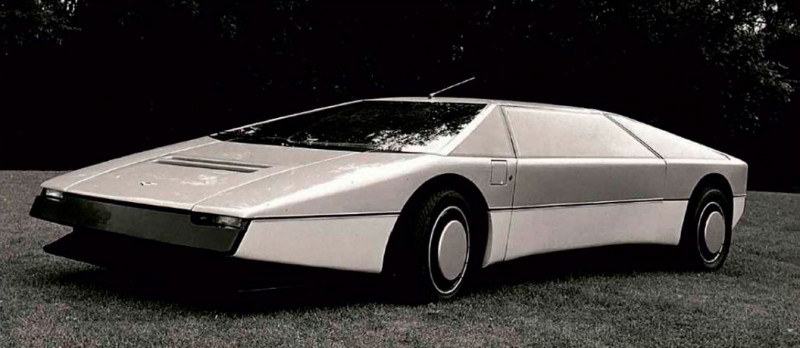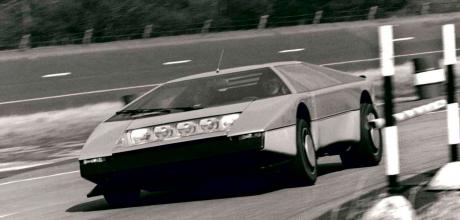1979 Aston Martin Bulldog - looking back Project K-9
Proof of concept. Original Bulldog project leader Keith Martin recalls the earliest road tests of Aston Martin’s pioneering supercar.
Looking Back Project K-9
It was the spring of 1980. Bulldog was a fully functioning road car and the team was rightly proud, having designed and built most of it in our special projects workshop at Newport Pagnell, with help from others in the company when the pressure was on. Even the initial ‘big bits’ had been extensively re-worked.

Just a few days after the launch on 27 March, it was due to be tested by Autocar, Car, Motor and Road & Track magazines. We’d only had time to do a shakedown run at MIRA, in the rain, to make sure everything worked and the car was safe. The first test was at Mallory Park circuit, organised at the last minute because of permit problems with MIRA. Paul Frère of Road & Track, being based outside the UK, did not have a MIRA track permit, and Car magazine was not welcome there because of its cavalier use of pre-release pictures of new cars.
For insurance reasons I had to be present in the passenger seat for the Mallory Park tests. After I’d driven AML chairman Alan Curtis around for a few laps, Paul Frère got to grips with the car and was soon exploring the limits of its handling and braking, this with the car virtually untested in its finished state. I was relieved at how well the car was standing up to this treatment. Mel Nicholls for Car magazine then had a few laps and seemed to be favourably impressed. We then loaded up and went over to MIRA, where Motor and Autocar were waiting. Motor won the coin toss and consequently got the lion’s share of the driving, spending over an hour speeding round the high-speed banking and the more twisty handling circuit. We had to curtail Autocar’s session as some electrical wires began smoking (too near an exhaust) and a few other teething troubles started to worry us. Fortunately the very experienced John Miles was still able to gain a lot of information from his shorter session and said ‘not to worry’.
Later, Miles kindly presented Steve Hallam and myself with framed prints of Vic Berris’s cutaway drawing. Mine still hangs in my office. Steve and I also got a congratulatory note from Mike Loasby, who came up with the original concept, which was kind of him.
We certainly couldn’t complain about the publicity for Aston Martin that Bulldog generated. We had some filming sessions for the BBC with Noel Edmonds, then fronting the Top Gear programme. Noel, incidentally, invited me to have a drive in his GT40, which we started by towing it with his wife’s Volvo estate before I set off alone around the country lanes. A most interesting experience, in some ways similar to pedalling Bulldog.
Steve H took the car to the Blue Peter studios for an appearance on live TV, and we were invited to make a demonstration run at the Birmingham Superprix and to open the Aston Martin Owners’ Club meeting at Silverstone with Stirling Moss. On that occasion, Steve and I sneaked in some testing in the morning, setting up dampers, etc, before the crowds arrived. Then a real pinch-yourself moment when Stirling asked me to show him round for a lap before he took over for a couple of faster laps. The first time I saw Stirling Moss at Silverstone I was in short trousers and he was driving the Vanwall.
Now he was asking me to show him how to drive a car, at Silverstone! Later on, Alan Curtis drove a few laps with Sir David Brown in the passenger seat. Tony Brooks also came by and asked some interesting questions about the car. Truly a day of Aston Martin living legends!
There was another with long links to Aston Martin: Roy Salvadori. I had the pleasure of his company for a day at Goodwood for a filming project about Aston Martin’s racing history. We did many laps together in Bulldog, both of us taking turns to drive with the other as passenger. I’d have thought the last place he needed showing round was Goodwood. I found Roy to be a real gentleman and greatly enjoyed chatting with him. Incidentally, he thought the car was a lot of fun.
For several months we had to tie in an intensive development and test programme with the publicity schedule. Many well-known personalities came to see the car or were driven in it; a few being allowed to drive it. They came from the royal family, government, industry and the media worlds. Most testing was done at MIRA and Steve Hallam or I usually drove the car there and back on the road. On one of these visits, we reached 172mph or thereabouts on one of MIRA’s short straights. We knew we had much more to go, though, as we were just getting into top gear!
Our sessions in the wind tunnel resulted in Bulldog being aerodynamically stable with a front axle lift of only about 210lb (95kg) at 200mph and none at the rear. (As a matter of interest the first GT40s developed a lift of over half the weight of the car at 200mph, and were notably unstable at about 150mph, a speed we had already greatly exceeded in Bulldog with no problem).
Steve had predicted the need for a rear anti-roll bar and we had duly designed and fitted one. This reduced understeer but Bulldog remained a neutral-handling car with a touch of understeer when pressing hard – ideal for a road car. In fact in all the times I drove the car I don’t recall a single hairy moment in the handling department. The only other significant changes were to move the oil coolers to the front of the car and completely redesign the exhaust system. After some failures and forensic analysis it was clear that the turbochargers were getting too hot. We moved them about 2ft further away from the engine and after that there were no more failures.
Unfortunately an economic recession was having its effect and the company had the unpleasant task of issuing redundancies. Sadly four of the Bulldog team (John Ceaser, Jim Corrie, Bob Clarke and Mike Duff) had to be included. Peter Collins and Steve Hallam were back on general development work, which left me without a team. At one stage I worked on Bulldog alone, then eventually even this had to stop, but I was still hankering after the high-speed run to ‘consummate’ the car at over 200mph.
By now (Christmas 1980) Victor Gauntlett was in charge and Alan Curtis had said goodbye. I was sorry to see Alan go, as it was his enthusiasm that got Bulldog started. Fortunately after a while the experimental department had some spare capacity and David Morgan set some of the fitters back on the car. We had a good look at the engine with ideas coming from David and our new engine designer from Cosworth, Alistair Lyle. In brief these included new modified Cosworth forged pistons, fettling of heads and inlet ports, higher-lift camshafts, new modified turbocharger innards and new injection intake manifolds. Arthur Wilson set up the engine on the test bed and almost immediately was getting over 700bhp at 6000rpm. It was looking good!
With the engine back in the car, we managed to have a few more test runs at MIRA. I usually drove, with Arthur Wilson as the observer, calmly recording 25 separate temperatures and other data as we flew around the high-speed circuit. The car being left-hand drive meant that he was up near the top of the banking – brave man!
By now Bulldog was going really well. On one occasion (29 May, 1981) we twice pulled over 191mph, verified from both the on-board Cranfield microwave speed measurer and the rev-counter, which was known to be spot-on. Just as significant to me was the fact that the car was quite happy chugging home down the M1 at 70mph and could easily be driven in traffic.
By May 1981 I felt the car was ready for its maximum speed run. Pirelli had kindly loaned us some special tyres, balanced, buffed and X-rayed, and I had installed a taller diff ratio to give a theoretical maximum of 237mph, but obviously we needed somewhere to test. Norman Dewis of Jaguar helpfully sent me a file of information about the Nardo test track in southern Italy and I was in contact with the VW test track at Wolfsburg in Germany. Nardo was a slightly banked eight-mile bowl circuit and Wolfsburg had a five-mile straight with a high-speed banked entry. Either would be suitable for our needs.
It was not to be, however. Victor and managing director John Symonds were in deep negotiations with one of the Saudi princes, who was offering a tempting sum to purchase the car. I asked Steve Hallam to demonstrate it to him as I couldn’t bring myself to do it. I might have been tempted to draw attention to the car’s faults! Eventually the deal was done and on 27 January 1982 he drove the car away from the factory, no road tax, no number plates. Naturally I was saddened but understood the need to raise some cash and at least the car was in the best form it had ever been in.
Finally, I am truly delighted that the new owner of the car has commissioned a complete nut-and-bolt rebuild, and what a fantastic job Nigel Woodward and his team at Classic Motor Cars are doing. I have transcribed all my old notes into over 60,000 words of reports in the hope that these may help explain some of our design decisions and testing history. Mostly, though, it has enabled me to re-live the privilege I had in heading a great team in building a superb motor car – and still be writing about it over 40 years on. How lucky is that?
Specification (launch spec)
- ENGINE V8, 5340cc, twin turbochargers, Bosch mechanical fuel injection
- MAX POWER c650bhp @ 6500rpm
- MAX TORQUE c550lb ft @ 4500rpm
- TRANSMISSION Five-speed manual gearbox and transaxle, rear-wheel drive, LSD
- SUSPENSION Front: double wishbones, coil springs, telescopic dampers, anti-roll bar. Rear: de Dion tube, trailing arms, Loasby link, coil springs, telescopic dampers, anti-roll bar
- STEERING Rack-and-pinion, unassisted
- BRAKES Vented discs, 296mm front and rear, four-piston calipers
- WHEELS 8.5 x 15in front, 11 x 15in rear
- TYRES 225/50 VR15 front, 345/35 VR15 rear, Pirelli P7
- WEIGHT 1575kg
- POWER TO WEIGHT 420bhp/ton
- 0-60MPH c4.5sec (est)
- TOP SPEED 200mph+
Above Bulldog as it was presented to the world in March 1980. Nine months of development and public relations duties followed. Clockwise from top left Wonderful cutaway by Vic Berris appeared in Autocar, which was one of the four magazines to test the car in April 1980; Noel Edmonds drove it for Top Gear on the telly; high-speed runs were on MIRA’s banked circuit; Stirling Moss is talked through the Bulldog by project chief Keith Martin.
‘Paul Frère got to grips with the car and was soon exploring the limits of its handling and braking, this with the car virtually untested in its finished state’


